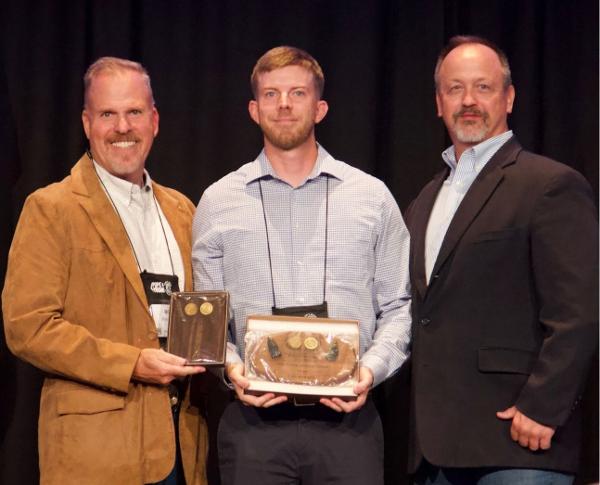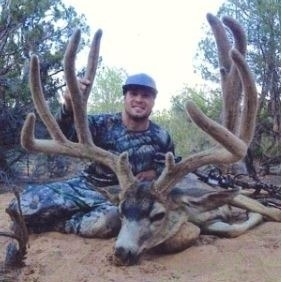From Bowhunting Big Game Records, 1st Edition, 1975
The infrequently presented Ishi Award is the highest honor which the Pope and Young Club can bestow upon a bowhunter. It is awarded only when a truly outstanding North American big game trophy animal is deserving of recognition. A nomination and selection committee, comprised wholly of the Club’s Board of Directors, determines each selection after careful evaluation.
 L to R - Roy Grace, Luke Brewster (2021 Award Winner), Kurt Ebers
L to R - Roy Grace, Luke Brewster (2021 Award Winner), Kurt Ebers
The story behind the award really begins with its Indian namesake who was completely unknown to civilized man until daybreak on the morning of August 29, 1911. That day the dawn stillness was shattered by the excited barking of dogs. Roused from their sleep, the occupants of a slaughterhouse near the village of Oroville, California investigated the racket.
Cowering in a corner of their corral, emaciated from starvation and near the limits of fear and exhaustion, was a primitive Indian. The terror stricken man, obviously believing he was about to be killed, was taken into custody and housed in the Oroville jail.
Communication with his captors and “civilized” Indians living nearby proved impossible; however, news of the savage’s capture soon spread and reached the attention of two professors of anthropology at the University of California. These two men, Professors Alfred Kroeber and T.T. Waterman, journeyed from San Francisco to Oroville with the hope of discovering the ancestry of this “wild man”. Finally, after unsuccessfully trying many different tribal tongues, Professor Waterman spoke a word in the Yana language which was met with an instant response.
At last the Indian could be told he was not facing imminent death at the hands of the white men. Reassured, his appetite improved and he began to quickly adjust to life in what for him was surely a strange new world. And so Ishi, the last surviving member of the ancient tribe of Yana Indians, was transported directly from the Stone Age into a complex, modern society.
The professors took Ishi back to San Francisco with them and gave him living quarters in the University’s museum. It was here that Dr. Saxton Pope, an instructor at University School of Medicine, was called in to make a physical examination of the Indian. This professional meeting developed into a strong friendship. Soon Ishi was showing Dr. Pope and his companion, Art Young, how to make and use bows and arrows for hunting. Although Ishi lived only five years in civilization before succumbing to tuberculosis, his memory lives on in the writings of Pope and Theodora Kroeber, the wife of one of the professors who first befriended him.
Consequently, in late 1962 when the Pope and Young Club introduced the idea for a special bowhunting award, Dick Mauch’s suggestion that it be named in honor of Ishi was met with immediate and enthusiastic response. After all, it was Ishi who had instilled in Pope and Young the love of the bow and its use as an efficient hunting tool. What then could be more appropriate than honoring the individual who had done most to inspire the “fathers of modern bowhunting”?
 Bowdy Gardner's World Record Typical Mule Deer in Velvet - 2023 Ishi Award
Bowdy Gardner's World Record Typical Mule Deer in Velvet - 2023 Ishi Award
The Ishi award concept belongs to Mauch, Glenn St. Charles, Fred Bear and Chuck Kroll. They had been searching for an award similar to the Boone and Crockett Club’s coveted Sagamore Hill Medal honoring the memory of Theodore Roosevelt. Their suggestion for a special Ishi Award was quickly accepted by the membership.
The award itself was designed by Fred Bear with assistance from Chuck Kroll. Bear owned a few pieces of some very fine, select grade rosewood which were nearly perfect in color, grain and texture. This wood was donated to the Club to serve as plaques for what was to become bowhunting’s most rare and distinctive award. Next, specially made obsidian spear points were fashioned by Jim Ramsey of Lincoln, New Mexico, undoubtedly a master at this ancient art. These had-chipped points, mounted on each rosewood plaque along with an engraved metal plate, complete the treasured Ishi Award.
To date, only twenty one of the special bowhunting awards have been presented. The first Ishi Award, presented in 1964, was for the tremendous non-typical whitetail deer bagged by Del Austin. This trophy from Hall County, Nebraska, set a new Pope & Young World's Record at that time.
The last Award presentation was made, following the Thirty Thrid Recording Period, in 2023. Although, World Record trophies were entered in numerous categories, the decission for this ballot did not take long. The winner was the world's largest ever recorded, hunter taken, Typical Mule Deer with any weapon. Bowdy Gardner shot this World Record Typical Mule Deer - in Velvet, in 2012 in Kane County, Utah.